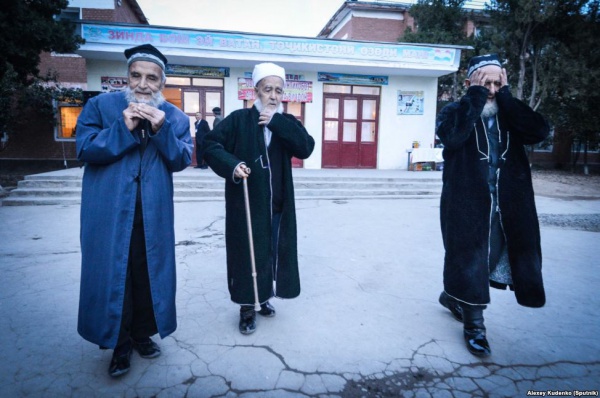
Tajikistan’s Islamist Extremists Concentrated in Big Cities at Home and in Russia
Publication: Eurasia Daily Monitor Volume: 15 Issue: 34
By:

Despite popular misperceptions of religiosity in general and Islam in particular flourishing most strongly in poor rural areas, the Islamist revival of the last 30 years has been primarily an urban phenomenon. This has been the result of the loss of familial ties by those who moved from villages into the rapidly growing cities as well as the communication revolution, which has allowed Islamist activists to reach the new urbanites. That is what happened in Iran and in the countries affected by the Arab Spring. And it is now occurring in Central Asia—and nowhere more than in Tajikistan, the most Islamic, and one can also say Islamist, country in that region (see EDM, February 6).
The rise of Salafists and Wahhabists in major Tajikistani cities and among Tajik diasporas in Russian cities like Moscow have long been a concern for officials in Dushanbe, who fear that these movements could link up with other forces, domestic and foreign, to produce an Islamist revolution. The authorities have, thus, tried to prevent these trends from overwhelming traditional Tajik Islam. Most of their methods have proved counterproductive—be they closing down rural mosques or calling home some 6,000 Tajikistanis studying in madrassahs abroad but not providing them with jobs on their return (News.tj, November 3, 2017; see EDM, February 6, 2018). As a result, the situation has reached critical mass, and an Islamist explosion in Tajikistan’s cities is increasingly likely.
Two Tajikistani experts, Khokim Mukhabbatov and Mavdzhigul Ibadullayeva of the Muslims Against Narcotics, Extremism, Force and Terrorism, describe in some detail how that precarious situation came about (Islamio.ru, February 23). They note that Salafism or Wahhabism, as this trend is usually referred to in Tajikistan, arrived there already in the 1980s, as a result of the Iranian revolution and the war in Afghanistan. From the beginning, most of the Salafists and Wahhabists there were young men between the ages of 18 and 30 who had left their villages for the cities or for work in the Russian Federation. Lacking the stability their families and the local rural mullahs provided, they were prime candidates for recruitment by Salafists from abroad. That is still the case today. And the size of this cohort has increased as the cities have swelled in size and the number of Tajiks who have worked in Russian cities has risen over the last 15 years.
These young people, the two experts say, have had their religious worldview formed not by imams and mullahs in their villages but by Internet sites that appealed to them as Muslims rather than as villagers or Tajiks. It was only a short step from there for them to become recruits for the Caliphate (Islamic State) and to take up jihad against other Muslims—including Shiias and the Ismailis, both of whom have strong communities in Tajikistan, and Sunnis, who the web preachers said had sold out their faith.
A decade ago, Mukhabbatov and Ibadullayeva say, Tajikistani Senator Oli Turadzhonzoda already warned that “the Salafists have the upper hand in several major cities. In the kishlaks [rural settlements], districts and rural areas, there are almost none of them.” That pattern continues to this day, the two experts contend.
Dushanbe has vacillated between incentives and suppression to deal with the domestic growth of Islamism. On the one hand, the government has tried to make concessions such as amnesties and reaching out to Salafist backers in Qatar and Saudi Arabia. On the other hand, the authorities have cracked down hard on Salafists and Wahhabists inside the country—especially upon their return from studying abroad or working in the Russian Federation—by adopting new laws that impose draconian sentences of many years in prison for such activities. Neither approach has worked, the two experts say. The first has been taken by the Salafists as an indication of their own strength and the weakness of the Tajikistani government. And the second has created an ever larger group of people either in prison or listed as extremists who have no reason to support the government and every reason to join with others in opposing it or even seeking its overthrow.
The Salafists and Wahhabists have a real advantage compared to Tajikistan’s government: they understand and can use modern technologies to reach and organize their followers, something Dushanbe lags in, Mukhabbatov and Ibadullayeva argue. But that is not their only advantage. The Salafis reject most of modern science even as they use its fruits, the two continue. But they are particularly sensitive to traditional ways. Unlike the government, they use local dialects in reaching out even to their urban followers “in order to more quickly find a common language” and “strengthen their influence” in the country as a whole via their urban constituency. In addition, they reject any attention to the pre-Islamic history of the country, oppose the use of Russian in Tajikistan, and reject all efforts to improve ties with Moscow.
Recognition is growing in Dushanbe, the experts note, that the Salafists are gaining too many advantages and that Tajikistan’s authorities need to adopt a more effective strategy to counter them. But as of now, they suggest, few in the government have any good ideas as to what such a strategy should look like.



